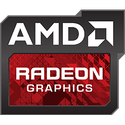Friday, July 12th 2019

AMD Retires the Radeon VII Less Than Five Months Into Launch
AMD has reportedly discontinued production of its flagship Radeon VII graphics card. According to a Cowcotland report, AMD no longer finds it viable to produce and sell the Radeon VII at prices competitive to NVIDIA's RTX 2080, especially when its latest Radeon RX 5700 XT performs within 5-12 percent of the Radeon VII at less than half its price. AMD probably expects custom-design RX 5700 XT cards to narrow the gap even more. The RX 5700 XT has a much lesser BOM (bill of materials) cost compared to the Radeon VII, due to the simplicity of its ASIC, a conventional GDDR6 memory setup, and far lighter electrical requirements.
In stark contrast to the RX 5700 XT, the Radeon VII is based on a complex MCM (multi-chip module) that has not just a 7 nm GPU die, but also four 32 Gbit HBM2 stacks, and a silicon interposer. It also has much steeper VRM requirements. Making matters worse is the now-obsolete "Vega" architecture it's based on, which loses big time against "Navi" at performance/Watt. The future of AMD's high-end VGA lineup is uncertain. Looking at the way "Navi" comes close to performance/Watt parity with NVIDIA on the RX 5700, AMD may be tempted to design a larger GPU die based on "Navi," with a conventional GDDR6-based memory sub-system, to take another swing at NVIDIA's high-end.
Source:
Cowcotland
In stark contrast to the RX 5700 XT, the Radeon VII is based on a complex MCM (multi-chip module) that has not just a 7 nm GPU die, but also four 32 Gbit HBM2 stacks, and a silicon interposer. It also has much steeper VRM requirements. Making matters worse is the now-obsolete "Vega" architecture it's based on, which loses big time against "Navi" at performance/Watt. The future of AMD's high-end VGA lineup is uncertain. Looking at the way "Navi" comes close to performance/Watt parity with NVIDIA on the RX 5700, AMD may be tempted to design a larger GPU die based on "Navi," with a conventional GDDR6-based memory sub-system, to take another swing at NVIDIA's high-end.

123 Comments on AMD Retires the Radeon VII Less Than Five Months Into Launch
There's a reason Nvidia hasn't made a V100 successor with Turing and GDDR6.
HBM, in its current implementation really didn't bring much to the people. So, yay for that innovation? What really did it bring us???? They pushed GCN forward several generations... middling performance at more power use (but its cheaper!!!)... what did I miss?Where was this sentiment when RTX came out with ray tracing?
People: i feel cheated,r@ped,hatred towards Nvidia.
When AMD retires Radeon vii for Radeon 5700 XT series ($699 vs $399)
People: Good Move..it was only a Productivity card.. not needed for Gaming
....
No one in their right mind would consider buying it for price/performance.
Anyway, those that did get it have a nice piece of history "First consumer GPU on 7nm". YAY !
As long as they do what I want them to do it's all good and I intend to use them until they are done - At least get some use back vs the investment. One is doing great as the card in my daily, the other I stashed back in the box after a 24hr bout of folding along side the one used as my daily.
Since it did well I know it's OK and it's been in the box ever since.....
Waiting for that rainy day I might need it or just whatever.
Benching?
Possibly - U never know.
Got mine and I'm happy with them, nuff said on that. Not looking at it in collector's terms, I am using the one with the other in reserve if it's ever needed.
They helped design the HBM standard and then all the FPGAs and compute cards started using it.
The memory makers then decided they could charge more and increased the price 4x or more.
So between Vega demo and price announcement the price increased 4x on their hbm and it screwed over the competitiveness.
Vii therefore was not an expected consumer product but was always a stopgap/defective mi50.
It cannot be decreased in price at all without losing money and the 5700xt is nipping at it as is.
Big navi was too power hungry and got bumped to 7nm+ for 15% power reduction.